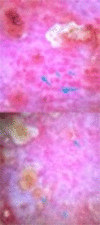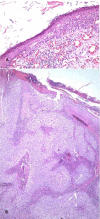Development of poorly differentiated invasive squamous cell carcinoma in giant Bowen's disease: a case report with dermatoscopy
- PMID: 27222765
- PMCID: PMC4866620
- DOI: 10.5826/dpc.0602a02
Development of poorly differentiated invasive squamous cell carcinoma in giant Bowen's disease: a case report with dermatoscopy
Abstract
Bowen's disease (BD) is an in situ form of squamous cell carcinoma (SCC), often occurring in the chronically UV-damaged skin of elderly people. The risk of progression of BD to invasive SCC varies between 3% and 5%, and one-third of invasive tumors may metastasize. Herein we discuss the dermatoscopic findings of a case of giant Bowen's disease, which progressed to poorly differentiated invasive SCC.
Keywords: Bowen’s disease squamous cell carcinoma; dermatoscopy; dermoscopy.
Figures




Similar articles
-
Dermatoscopic findings and dermatopathological correlates in clinical variants of actinic keratosis, Bowen's disease, keratoacanthoma, and squamous cell carcinoma.Dermatol Ther. 2021 May;34(3):e14877. doi: 10.1111/dth.14877. Epub 2021 Mar 7. Dermatol Ther. 2021. PMID: 33583118
-
High-risk human papillomavirus in a child with digital pigmented Bowen's disease: Case report and dermoscopic findings.Pediatr Dermatol. 2018 Sep;35(5):e265-e267. doi: 10.1111/pde.13552. Epub 2018 Jun 22. Pediatr Dermatol. 2018. PMID: 29931706
-
Cyclin A and beta-catenin expression in actinic keratosis, Bowen's disease and invasive squamous cell carcinoma of the skin.Br J Dermatol. 2005 Dec;153(6):1166-75. doi: 10.1111/j.1365-2133.2005.06898.x. Br J Dermatol. 2005. PMID: 16307653
-
Bowen's Disease in Dermoscopy.Acta Dermatovenerol Croat. 2018 Jun;26(2):157-161. Acta Dermatovenerol Croat. 2018. PMID: 29989873 Review.
-
Race-Specific and Skin of Color Dermatoscopic Characteristics of Skin Cancer: A Literature Review.Dermatol Pract Concept. 2023 Oct 1;13(4 S1):e2023311S. doi: 10.5826/dpc.1304S1a311S. Dermatol Pract Concept. 2023. PMID: 37874992 Free PMC article. Review.
Cited by
-
Giant Bowen's Disease on the Face: Case Report and Review of the Literature.Open Access Maced J Med Sci. 2019 Feb 22;7(4):606-609. doi: 10.3889/oamjms.2019.190. eCollection 2019 Feb 28. Open Access Maced J Med Sci. 2019. PMID: 30894921 Free PMC article.
References
-
- Kossard S, Rosen R. Cutaneous Bowen’s disease. An analysis of 1001 cases according to age, sex, and site. J Am Acad Dermatol. 1992;27:406–10. - PubMed
-
- Reizner GT, Chuang TY, Elpern DJ, Stone JL, Farmer ER. Bowen’s disease (squamous cell carcinoma in situ) in Kauai, Hawaii. A population-based incidence report. J Am Acad Dermatol. 1994;31:596–600. - PubMed
Publication types
LinkOut - more resources
Full Text Sources
Other Literature Sources
Research Materials
